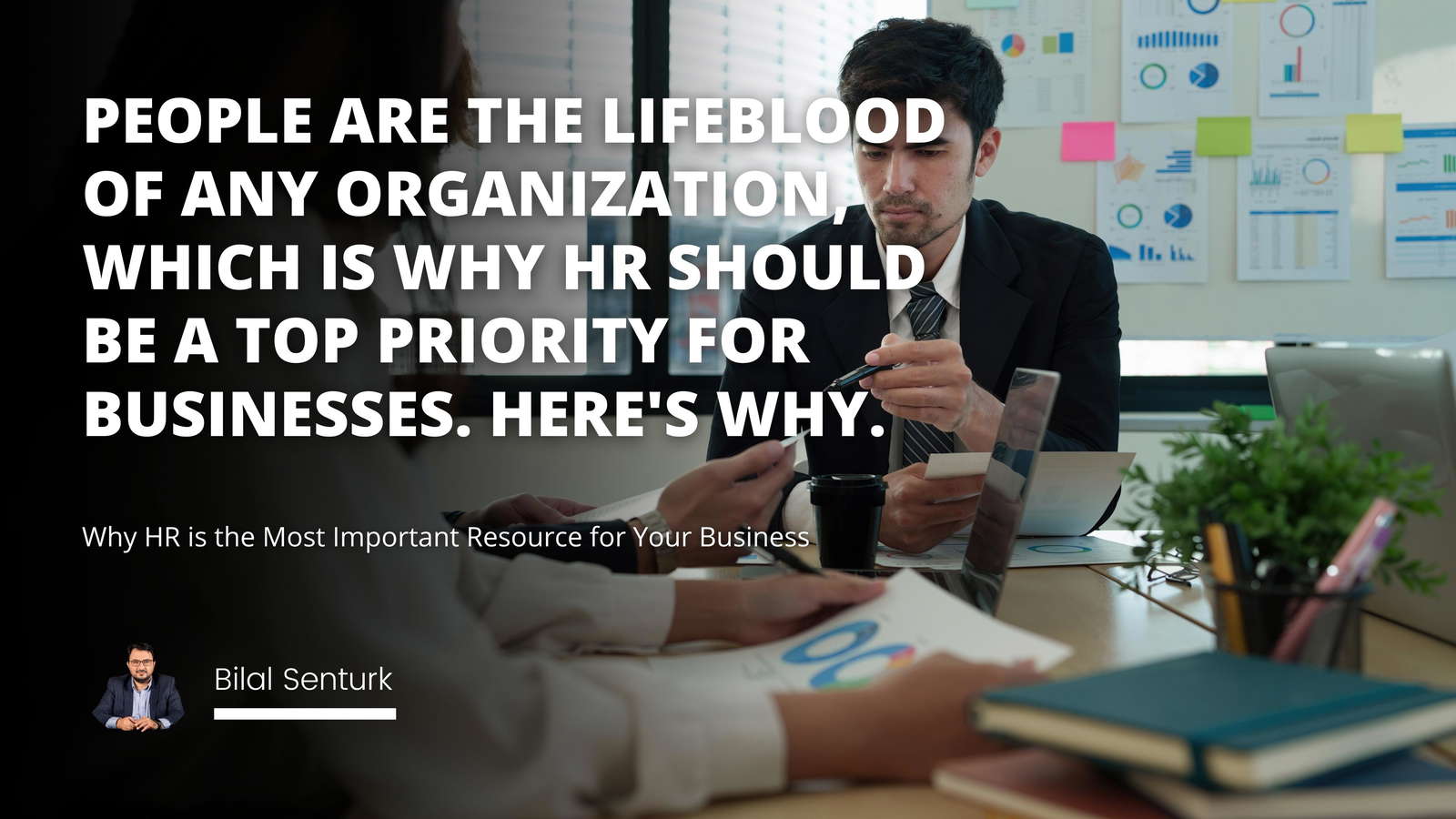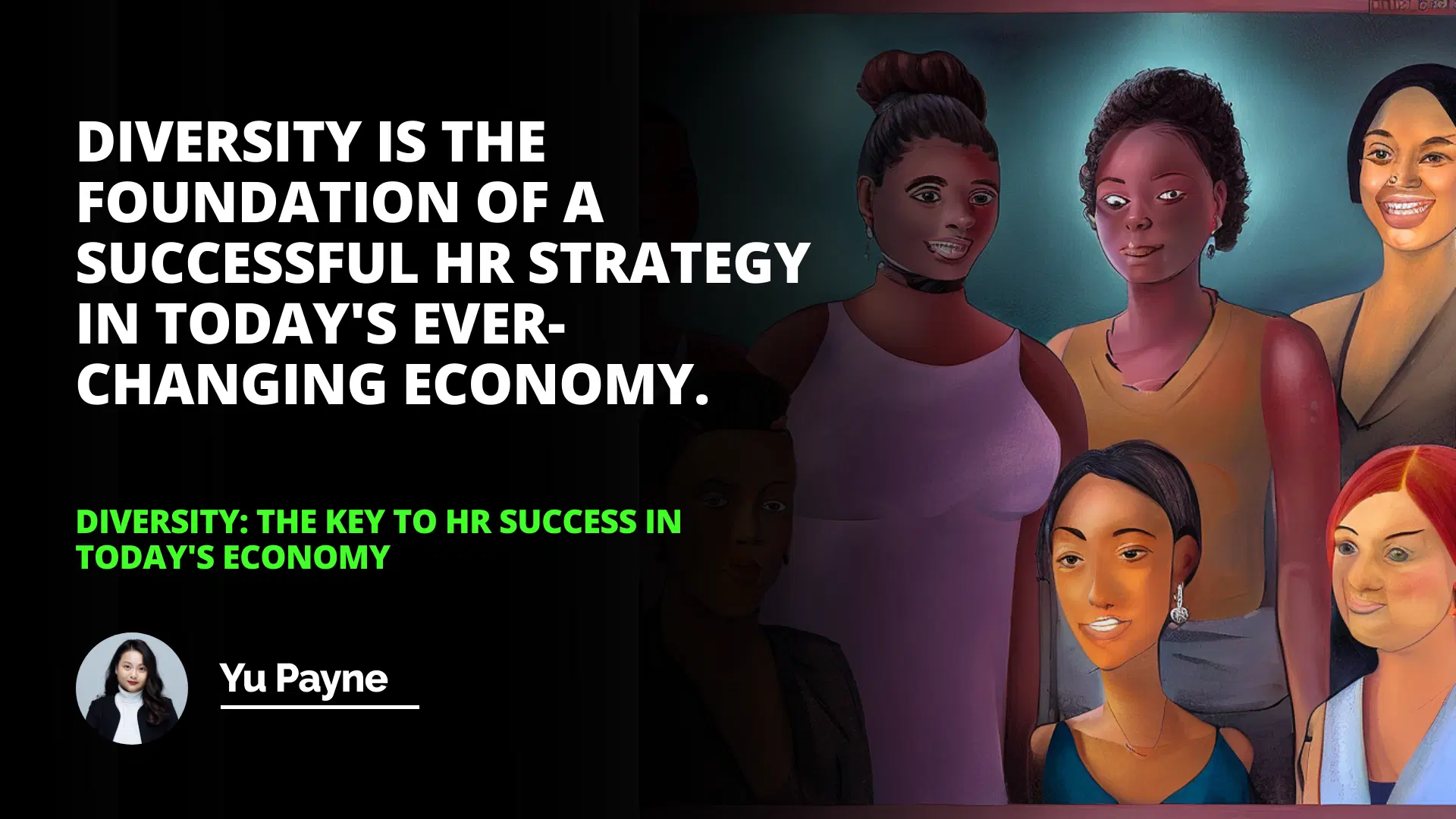
This article discusses the importance of diversity in the workplace and how it can benefit organizations. It defines diversity and provides examples of organizations that embrace it and the advantages of a diverse workforce. Organizations can benefit from a more productive, innovative, and attractive workplace by creating an environment that is respectful of all employees and actively recruiting and promoting employees from various backgrounds and perspectives.
Introduction
Definition of Diversity
Examples of Diverse Organizations
Benefits of a Diverse Workforce
Conclusion
Introduction: The human resources (HR) field is ever-evolving, and HR practitioners today must understand the link between diversity and business success. Diversity can mean different things to different organizations. Still, it is generally understood to include a range of characteristics, including age, race, gender, sexual orientation, disability, communication style, and career experience. This article will define diversity in the workplace, provide examples of diverse organizations, and discuss the benefits of a diverse workforce.
Definition of Diversity
Diversity in the workplace creates an inclusive environment that respects, values, and celebrates the differences of all employees. This includes differences in age, race, gender, sexual orientation, disability, communication style, and career experience. Organizations can foster an open and productive workplace by creating an environment that is respectful of all employees. Additionally, diversity in the workplace can help organizations better understand their customers and the market and create more innovative solutions to challenges.
Examples of Diverse Organizations
Texas Instruments defines diversity as their "effectiveness at using the talents of people of different backgrounds, experiences and perspective." At the company, formerly BankBoston, diversity includes group differences such as age, race, gender, sexual orientation, and disabilities, and individual differences, such as communication style and career experience. In addition, Harvard Pilgrim Healthcare pays special attention to improving the representation of women and minorities in critical positions. These examples demonstrate how organizations can approach diversity differently and create a more diverse workplace.
Benefits of a Diverse Workforce
Organizations that embrace diversity can benefit from a range of advantages. For example, a diverse workforce can help organizations better understand their customers and the market and create more innovative solutions to challenges. Additionally, a diverse workplace can help organizations create a more positive work environment, as employees feel more respected and valued. Finally, a diverse workplace can help organizations attract and retain top talent, as employees are likelier to stay with an organization that values their differences.
Conclusion: Organizations today must recognize the importance of diversity in the workplace, as it can help them create a more productive and innovative environment, better understand their customers and the market, and attract and retain top talent. By creating an environment that is respectful of all employees, organizations can foster an open and productive workplace. Additionally, organizations should strive to create a diverse workplace by actively recruiting and promoting employees from various backgrounds and perspectives. By embracing diversity, organizations can reap the many benefits of a diverse workforce.
Diversity is the foundation of a successful HR strategy in today's ever-changing economy.
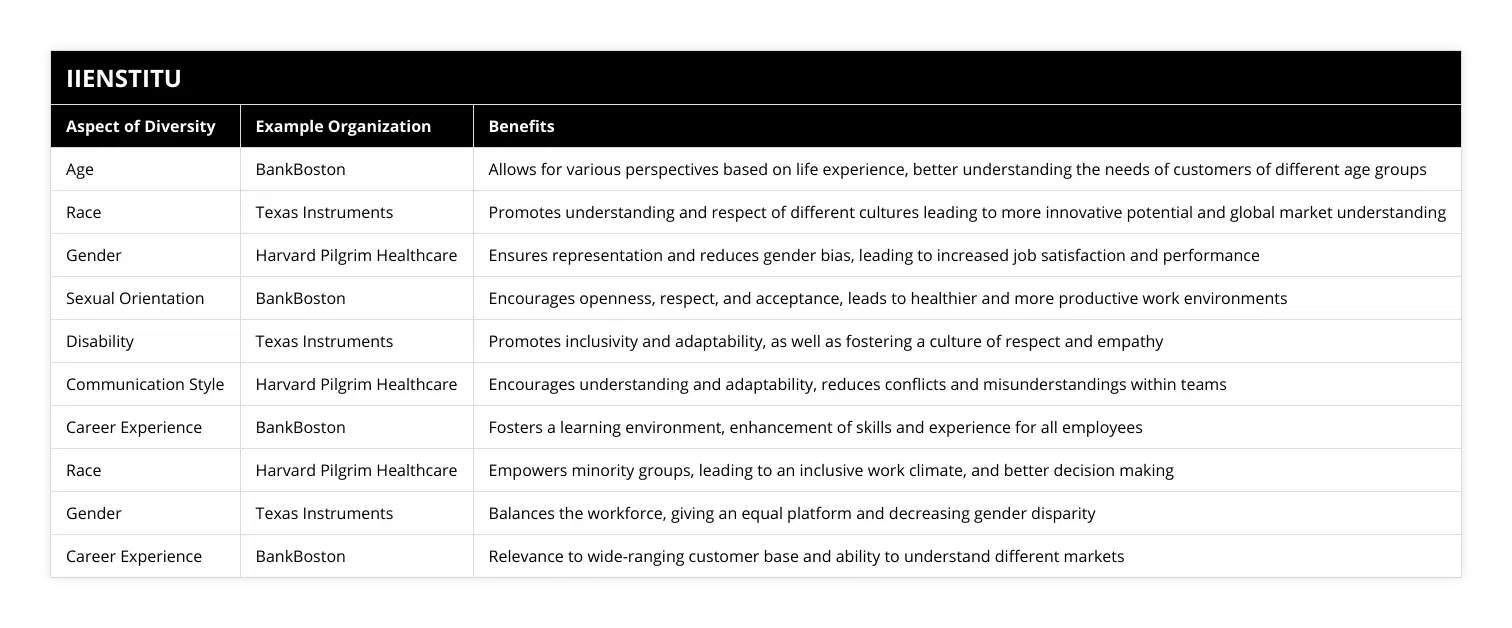
This article emphasizes the importance of workplace diversity and its benefits to organizations. Examples from Texas Instruments and Harvard Pilgrim Healthcare were utilized to further emphasize and crystallize this argument. Aspects of diversity including age, race, gender, sexual orientation, disability, communication style, and career experience were discussed, illustrating a broad sweep and inclusivity of diverse employee backgrounds. This diversity within the workforce enhances an organization's productivity and innovation, aiding in understanding customers and the market better and attracting and retaining top talent. The course HR practitioners need to take involves the integration of workplace diversity strategies for an open, respectful environment and improved business outcomes. In essence, embracing diversity is foundational to a thriving HR strategy amid today's rapidly changing economy.course hr
Frequently Asked Questions
What is the definition of diversity in the context of HR success?
Diversity in the context of Human Resources (HR) success can be defined as implementing practices and initiatives that embrace different aspects of people's identities, such as age, gender, ethnicity, ability, sexual orientation, and educational background. In addition, diversity initiatives seek to create an environment where diverse individuals are respected, appreciated, and included.
The success of diversity initiatives in the HR context is linked to the notion of an inclusive workplace. An inclusive workplace is one where all employees, regardless of their differences, feel comfortable, respected, valued, and included. The success of diversity initiatives is also linked to the notion of inclusivity, which is about creating an environment where all employees are respected, valued, and included, regardless of their differences.
The success of diversity initiatives in the HR context is also linked to the notion of equity, which is about creating an environment where all employees are treated fairly and equally, regardless of their differences. This includes ensuring that all employees are given equal access to the same opportunities and resources, irrespective of their differences.
The success of diversity initiatives in the HR context is also linked to the notion of cultural competence, which is about creating an environment where different cultures, backgrounds, beliefs, and values are respected, appreciated, and integrated into the workplace. This includes creating an environment where diverse perspectives and contributions are valued and appreciated.
Finally, the success of diversity initiatives in the HR context is also linked to the notion of engagement, which is about creating an environment where all employees have a sense of belonging and are engaged in their work. This includes creating an environment where employees feel respected, valued, and formed and where they can contribute to the success of the organization.
In conclusion, diversity in the context of HR success can be defined as implementing practices and initiatives that embrace different aspects of people's identities, such as age, gender, ethnicity, ability, sexual orientation, and educational background. It involves creating an environment where all employees are respected, valued, and included, and different perspectives and contributions are valued and appreciated. It also involves creating an environment where all employees are given equal access to the same opportunities and resources, regardless of their differences. Finally, it creates an environment where all employees have a sense of belonging and are engaged in their work.
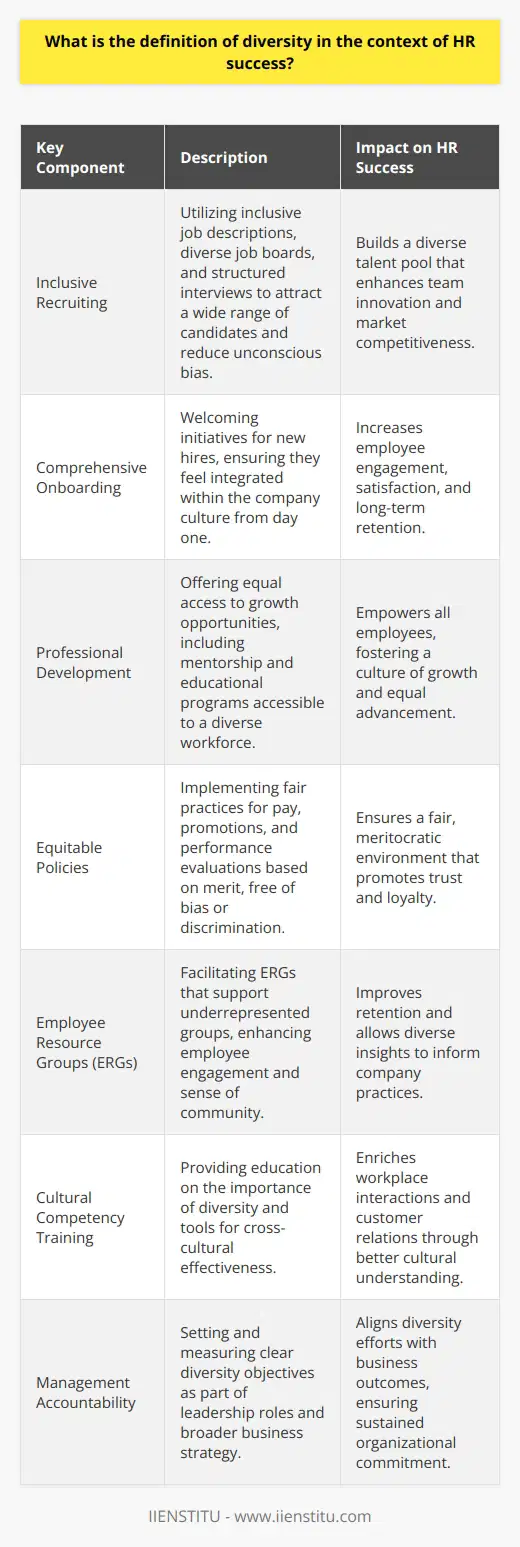
What are some examples of organizations that have successfully implemented diversity initiatives?
Organizations that have successfully implemented diversity initiatives have seen a variety of positive outcomes, including improved employee retention, increased employee engagement, and higher profits. Diversity initiatives are designed to create an inclusive workplace where all employees feel respected, valued, and appreciated. Examples of organizations successfully implementing diversity initiatives include Google, Microsoft, Apple, and Starbucks.
Google, a technology giant, has a long history of investing in diversity initiatives. Google has a dedicated diversity team led by a chief diversity officer and has established several initiatives to foster an inclusive and equitable workplace. These initiatives include employee resource groups, mentorship programs, and unconscious bias training. As a result, the percentage of underrepresented minorities at Google has grown from 2% to 8% in three years.
Microsoft, another technology giant, has invested in diversity initiatives since the early 2000s. Microsoft has established several initiatives to create an inclusive and equitable workplace, such as employee resource groups, unconscious bias training, and mentorship programs. Additionally, Microsoft has aimed to increase the representation of women and underrepresented minorities in leadership roles. As a result, Microsoft’s workforce has become more diverse, with underrepresented minorities making up 25% of their workforce and women making up 29%.
Apple, a consumer electronics company, has been a leader in diversity initiatives since the 1990s. Apple has established several industries, such as employee resource groups, mentorship programs, and unconscious bias training, to create an inclusive and equitable workplace. Additionally, Apple has aimed to increase the representation of women and underrepresented minorities in leadership roles. As a result, Apple’s workforce has become more diverse, with underrepresented minorities making up 25% of their workforce and women making up 33%.
Starbucks, a coffee company, has been investing in diversity initiatives since the early 2000s. Starbucks has established several initiatives to create an inclusive and equitable workplace, such as employee resource groups, unconscious bias training, and mentorship programs. Additionally, Starbucks has aimed to increase the representation of women and underrepresented minorities in leadership roles. As a result, Starbucks’ workforce has become more diverse, with underrepresented minorities making up 25% of their workforce and women making up 34%.
Organizations that have successfully implemented diversity initiatives have seen a variety of positive outcomes. For example, these organizations have seen improved employee retention, increased employee engagement, and higher profits. Additionally, these organizations have seen a more diverse and equitable workplace. Examples of organizations successfully implementing diversity initiatives include Google, Microsoft, Apple, and Starbucks.
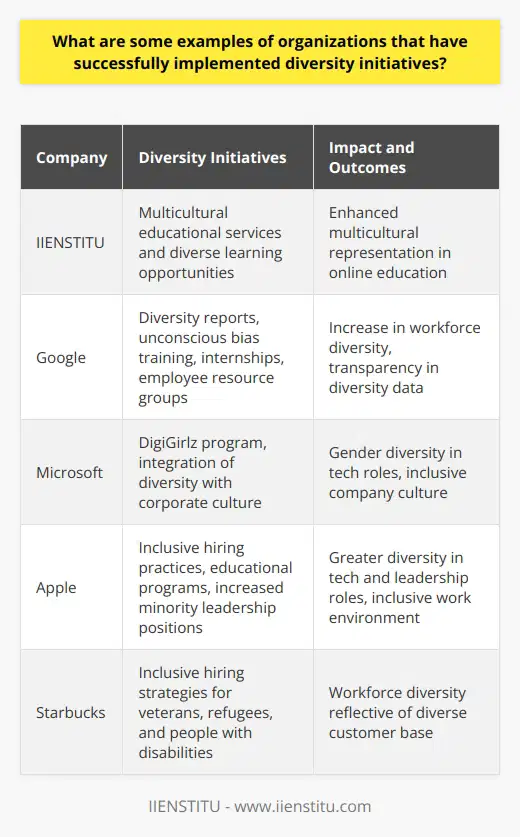
What are the benefits of having a diverse workforce in today's economy?
Organizations are increasingly appreciating the importance of having a diverse workforce in the modern economy. Diversity has been linked to greater creativity and innovation, increased employee engagement, and improved customer service. In this article, we will discuss the various benefits of a diverse workforce to an organization in today's economy.
today'sFirstly, a diverse workforce can give organizations a competitive advantage in today's complex and globalized environment. By having access to various perspectives, organizations can develop creative solutions to complex problems that would otherwise be difficult to identify. Diversity also brings a range of other skills and abilities that can be utilized to maximize the organization's potential.
Secondly, having a diverse workforce can help to create a more positive and productive work environment. Studies have shown that employees who feel respected and included in the workplace are more likely to be engaged and effective, which can lead to increased profitability for the organization. In addition, a diverse work environment can also help create an atmosphere of tolerance and understanding, which can positively affect the organization's culture and reputation.
Thirdly, having a diverse workforce can help organizations better understand their customers' needs. By accessing various perspectives and experiences, organizations can gain insight into their customer's needs and preferences, which can be used to create better products and services tailored to their needs. This can help organizations stay ahead of the competition and remain competitive in today's market.
In conclusion, having a diverse workforce can bring various benefits to organizations in today's economy. From providing a competitive advantage to creating a more positive work environment, organizations can capitalize on the many advantages that diversity can offer. As such, it is becoming increasingly important for organizations to invest in having a diverse workforce if they want to remain competitive and successful in today's global economy.

How does diversity strengthen the economy?
Economic Benefits of Diversity
Diversity, the inclusion of diverse individuals from different backgrounds, perspectives, and ideas, is crucial in today's interconnected world. A diverse workforce fosters innovation, productivity improvement, and resource utilization, all of which contribute to economic growth.
Innovation and Creativity Enhancement
In order to innovate and create new ideas, a diverse workforce is essential. People from various backgrounds bring unique experiences, perspectives, and ideas that can lead to the development of new products, services, and solutions. In a competitive global market, these innovations contribute to the growth and success of businesses, resulting in a stronger economy.
Boosting Productivity
The effectiveness and productivity of a diverse workforce can be attributed to the enhanced collaboration that results from multiple perspectives. When individuals from various backgrounds work together, they tend to push each other to excel, leading to improved outcomes and efficiency. As productivity increases, businesses generate greater profitability, which translates into economic growth.
Optimizing Resource Utilization
A diverse workforce promotes efficient resource utilization. Employers who embrace diversity are more likely to attract and retain top talent, leading to a dedicated, skilled, and competent workforce. Moreover, as businesses cater to global markets, a diverse workforce ensures they can appreciate and respond to the diverse needs of their customers. This understanding facilitates the effective use of resources and services to cater to the needs of different markets, ultimately contributing to the strength of the economy.
In conclusion, diversity strengthens the economy by enhancing innovation, increasing productivity, and optimizing resource utilization. By reaping the benefits of a diverse workforce, businesses can thrive and contribute to economic growth in a competitive global market. In our increasingly interconnected world, it is clear that embracing diversity is not only an ethical and moral imperative but also a key driver for economic development and success.
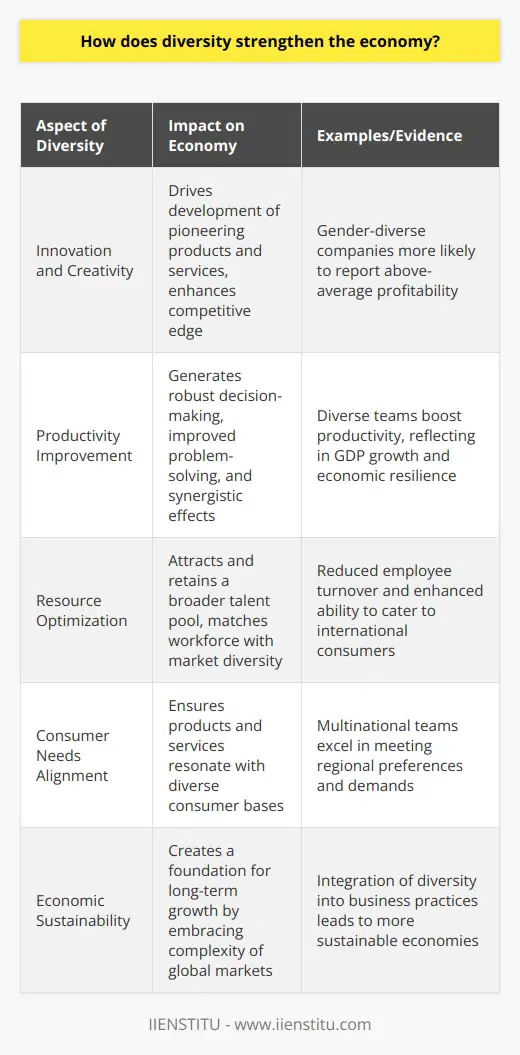
Why is diversity key to success in the workplace?
Understanding the Importance of Diversity
Diversity in the workplace is critical for success because it fosters innovation, creativity, and a wider range of ideas. By employing individuals from different backgrounds and with unique perspectives, companies gain access to a broader range of skills and viewpoints. These diverse perspectives lead to creative problem-solving, which can benefit businesses and organizations by enabling them to remain competitive in the dynamic and fast-paced global market.
Achieving Competitive Advantage
One key advantage of workplace diversity is the evident enhancement in competitiveness. A diverse workforce is more likely to identify unique opportunities and solutions, allowing businesses to differentiate themselves from their competitors. Additionally, diversity can help facilitate effective communication and collaboration among employees with distinct backgrounds, ultimately increasing productivity and efficiency.
Promoting Inclusivity and Collaboration
Workplace diversity also promotes a culture of inclusivity, where employees feel respected and valued. This inclusive environment fosters collaboration and encourages different perspectives to be shared. Moreover, when employees feel that their voices are heard and that they belong, they are more likely to remain committed to their organizations, resulting in reduced turnover and higher retention rates. Consequently, companies leveraging this strength by promoting diversity and inclusion enjoy tremendous benefits.
Attracting and Retaining Talent
A commitment to diversity can also help attract top talent to the organization. The modern workforce prioritizes a diverse and inclusive workplace, with many potential employees basing their job decisions on the organization's diversity and inclusion efforts. By showcasing a company's dedication to diversity, organizations can increase their prospective employee pool and recruit top-notch talent.
Conclusion
Ultimately, diversity is essential to success in the workplace because it drives innovation, competitiveness, inclusivity, and employee retention. Organizations that cherish this strong asset can not only survive but also thrive in the ever-evolving global market.
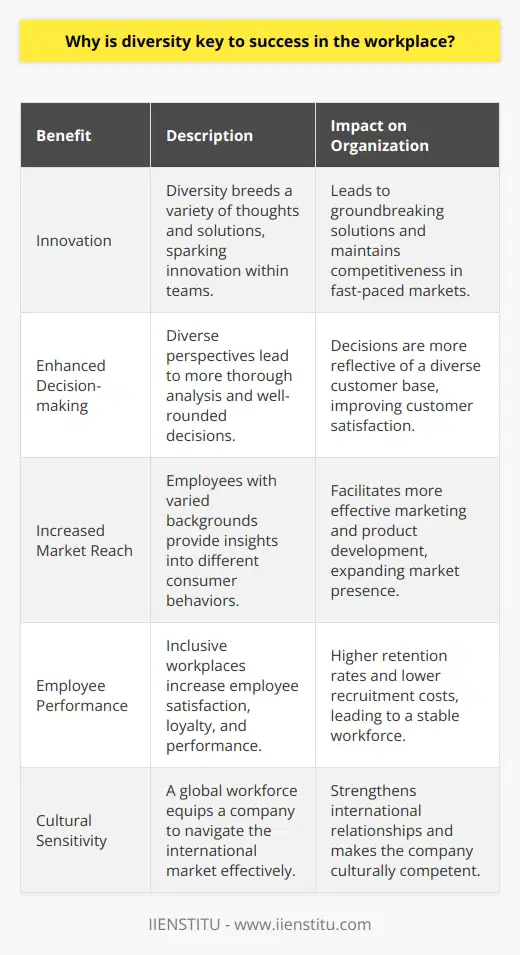
How is HR impacted by diversity in terms of talent acquisition and retention?
The Importance of Diversity in HR
Human resource (HR) management is significantly impacted by diversity in terms of talent acquisition and retention. As the modern workforce becomes more diverse, HR professionals need to understand, embrace, and leverage this diversity to create an inclusive, welcoming environment that fosters growth, productivity, and innovation.
Benefits of a Diverse Workforce
A diverse workforce brings together individuals from different backgrounds, experiences, and perspectives, enriching the collective knowledge, skills, and abilities of the organization. This diversity enables organizations to better understand and address the needs of diverse customers and clients, leading to increased customer satisfaction, loyalty, and profitability. Furthermore, diverse teams have been proven to perform better, making better decisions, and displaying higher levels of creativity and innovation.
Challenges in Talent Acquisition and Retention
However, attracting and retaining diverse personnel is not an easy feat. HR managers often face challenges such as unconscious bias during recruitment, selection, and promotion processes, which could lead to a lack of diversity in the organization. To overcome these challenges, HR professionals must establish targeted recruitment strategies and adopt diversity-conscious hiring processes that ensure equal opportunities for all applicants.
Inclusion and Equity in the Workplace
Promoting diversity is not only about hiring people from diverse backgrounds, but it also involves creating an inclusive and equitable work environment that fosters positive interaction and collaboration among its employees. HR managers must develop and implement diversity training and education programs that equip the workforce with the necessary tools and knowledge to understand, appreciate, and manage the differences that exist within it.
Employee Retention Strategies
Retaining diverse talent requires organizations to adopt employee-centered policies and practices that cater to the varying needs of their workforce. HR professionals must establish flexible work arrangements, competitive compensation packages, and targeted career-development opportunities that not only meet the expectations of their diverse employees, but also empower them to thrive professionally and personally.
Conclusion
Overall, the modern workplace is becoming increasingly diverse, and the HR function plays a crucial role in managing this diversity. By focusing on inclusive recruitment and employee-retention strategies, HR professionals can create a more inclusive work environment that values and appreciates the unique strengths that each individual brings to the table, ultimately enhancing overall organizational effectiveness and success.

How does HR address challenges in promoting an inclusive and diverse workplace?
Addressing Challenges in HR Promotions
Fostering Inclusive and Diverse Workplaces
Human Resources (HR) plays a pivotal role in promoting an inclusive and diverse workplace. By addressing various challenges effectively, HR ensures that organizations benefit from the unique skills, experiences, and perspectives of a diverse workforce.
Implementing Policies and Procedures
A key step in creating an inclusive and diverse environment is the implementation of robust policies and procedures. HR ensures that these policies are communicated effectively to all employees, and that training programs are in place to enhance staff understanding of diversity and inclusion initiatives.
Exercising Bias-Free Recruitment
To ensure a diverse workforce, HR must establish unbiased recruitment practices. This involves reviewing job advertisements, applicant screening tools, and interview questions to eliminate any potential bias. Emphasizing the value of diversity to hiring managers and interview panels can further support this effort.
Providing Mentorship and Support
HR can facilitate inclusive workplaces by promoting mentorship programs and providing safe spaces for employees to share their experiences. These initiatives empower employees to express their ideas, while fostering understanding and respect amongst colleagues with diverse backgrounds.
Mitigating Unconscious Bias
Unconscious bias can undermine diversity and inclusion efforts. HR addresses this challenge by providing training and resources to help employees identify and mitigate unconscious biases in their interactions and decision-making processes.
Ensuring Equitable Career Development
To retain a diverse workforce, HR must ensure employees have equal access to career development opportunities. By establishing transparent promotion processes and offering development programs that are accessible to all, HR can create a level playing field and improve employee retention.
Promoting Cultural Competence
Cultural competence is crucial for an inclusive and diverse workplace. HR plays an important role in training employees to appreciate and understand different cultures, beliefs, and customs, thereby enhancing intercultural relationships and collaboration within the organization.
In conclusion, HR's proactive approach to promoting inclusive and diverse workplaces addresses challenges in policy implementation, recruitment, employee support, unconscious bias mitigation, career development, and promotion of cultural competence. These efforts can ultimately result in more innovative and productive organizations that reap the benefits of a diverse workforce.
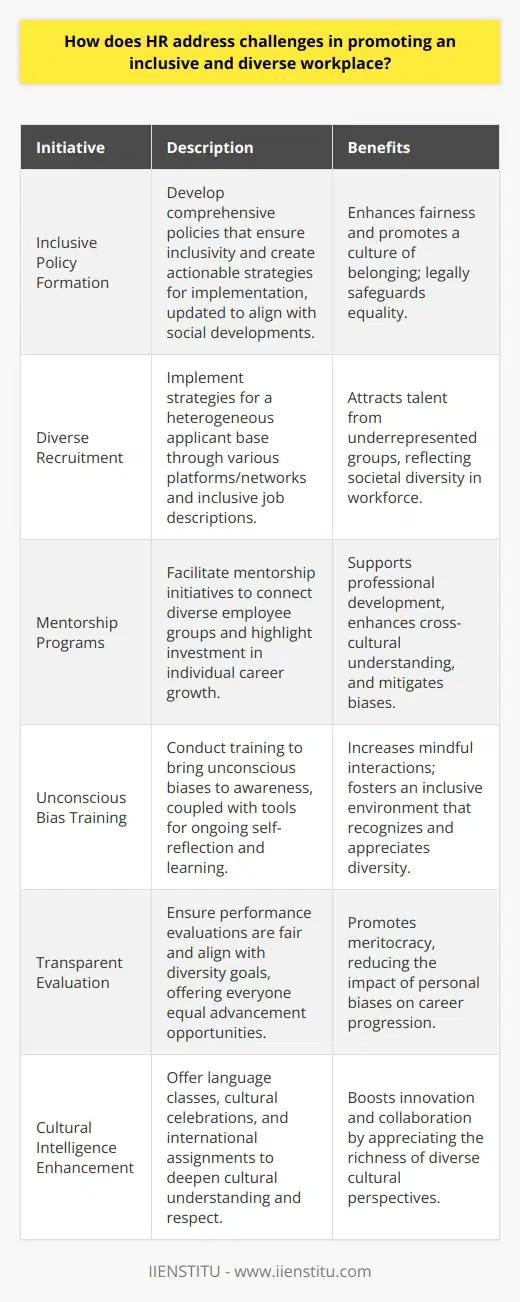
What strategies can HR implement to foster a truly diverse environment?
Strategies for Diversity in HR
Various strategies can be implemented by human resource departments to foster a truly diverse environment in the workplace. These strategies aim to promote inclusivity and acceptance, benefiting not only the company culture but also the organization's performance.
Recruitment and Selection
The first strategy to implement diversity is to review recruitment and selection processes. HR professionals should ensure that job advertisements are inclusive, using language that attracts a wide range of candidates. Additionally, providing bias-free assessments and conducting a blind resume screening can help eliminate discrimination during the hiring process.
Training and Development Programs
Another strategy is offering training and development programs that educate employees on diversity and inclusion. These programs should focus on topics such as unconscious bias, cultural awareness, and equal opportunity. By providing employees with the knowledge and tools to understand and combat discrimination, the work environment becomes more inclusive.
Flexibility in Work Arrangements
Implementing flexible work arrangements can also promote diversity by catering to the needs of employees with different backgrounds and lifestyles. Examples include flexible work hours, remote working options, or job-sharing opportunities. These arrangements allow employees to balance work and personal commitments and contribute to a more inclusive work environment.
Support Networks and Resource Groups
The establishment of support networks and resource groups for employees from diverse backgrounds is another key strategy. These forums can provide opportunities for employees to share their experiences and express their concerns, strengthening a sense of belonging in the workplace.
Mentoring Programs
Mentoring programs can also help create a diverse environment by pairing senior employees with junior staff from different backgrounds. These relationships can foster a sense of understanding and acceptance among colleagues, as well as provide valuable guidance and support for personal and professional development.
Performance Evaluation
Lastly, reviewing performance evaluation processes to ensure they are free from bias is essential in fostering a diverse work environment. HR should establish objective criteria and consider implementing feedback from multiple sources, including peers, supervisors, and subordinates, to reduce the potential for discrimination.
In conclusion, implementing these strategies is essential for organizations aiming to create a truly diverse environment. By promoting inclusivity and equal opportunity, HR professionals can pave the way for a more harmonious and prosperous workplace.
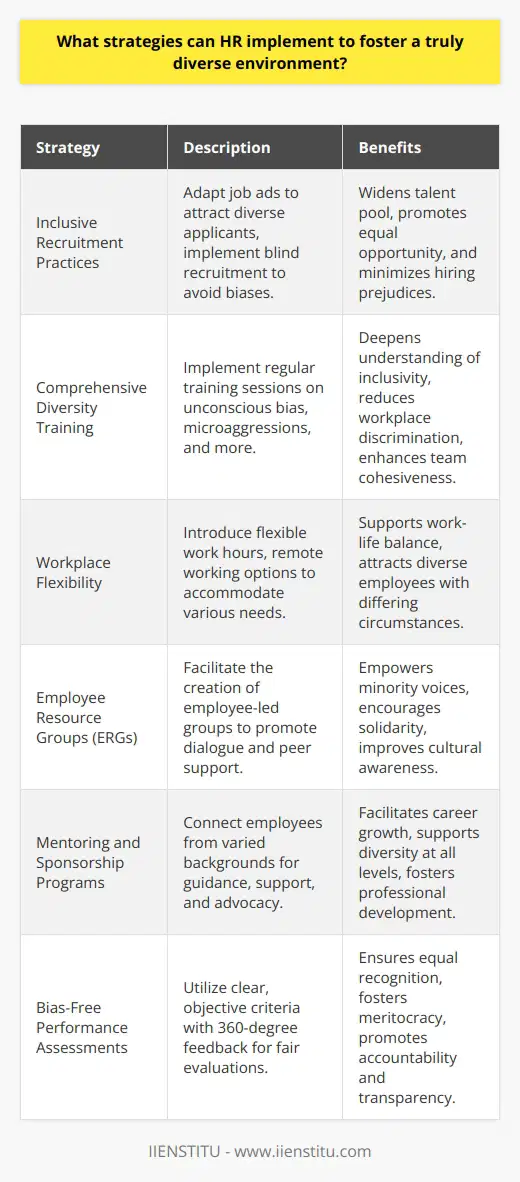
How do different aspects of diversity, such as cognitive and demographic diversity, contribute to overall organizational success?
Cognitive Diversity and Organizational Success
Cognitive diversity refers to the variety of thinking styles, skills, and abilities present in an organization. Embracing cognitive diversity leads to increased creativity and innovation, as individuals with different thought processes contribute unique perspectives and ideas. This benefits an organization by enabling the development of new solutions, products, and services, resulting in a competitive advantage in the marketplace.
Demographic Diversity and Organizational Success
Demographic diversity encompasses the differences in age, gender, ethnicity, and other such factors among members of an organization. Promoting demographic diversity creates a workforce that more effectively understands and communicates with diverse customers and stakeholders. This engenders greater customer satisfaction and improves the overall success of the organization. Additionally, a diverse workforce can foster a more inclusive and positive work environment, leading to higher job satisfaction and reduced employee turnover.
Linking Diversity to Organizational Success
A combination of cognitive and demographic diversity within an organization can lead to enhanced problem-solving capabilities. By bringing together individuals with distinct backgrounds and experiences, the organization can leverage a wider range of ideas, opinions, and approaches, resulting in improved decision-making processes. Communication and collaboration among diverse team members can also facilitate the exchange of knowledge and learning, thereby contributing to the continued growth and success of the organization.
Workforce Diversity as a Strategic Approach
Organizations can benefit from strategically embracing and promoting workforce diversity. In doing so, they position themselves to attract and retain top talent across various demographics and cognitive styles to support and drive the success of the organization. By recognizing and valuing each team member’s unique contributions, organizations can cultivate a culture that fosters both individual and organizational success.
In conclusion, both cognitive and demographic aspects of diversity have a significant impact on an organization’s overall success. By fostering an inclusive environment and encouraging the unique contributions of each individual, organizations can harness the power of diversity to drive innovation, creativity, and sustained growth.
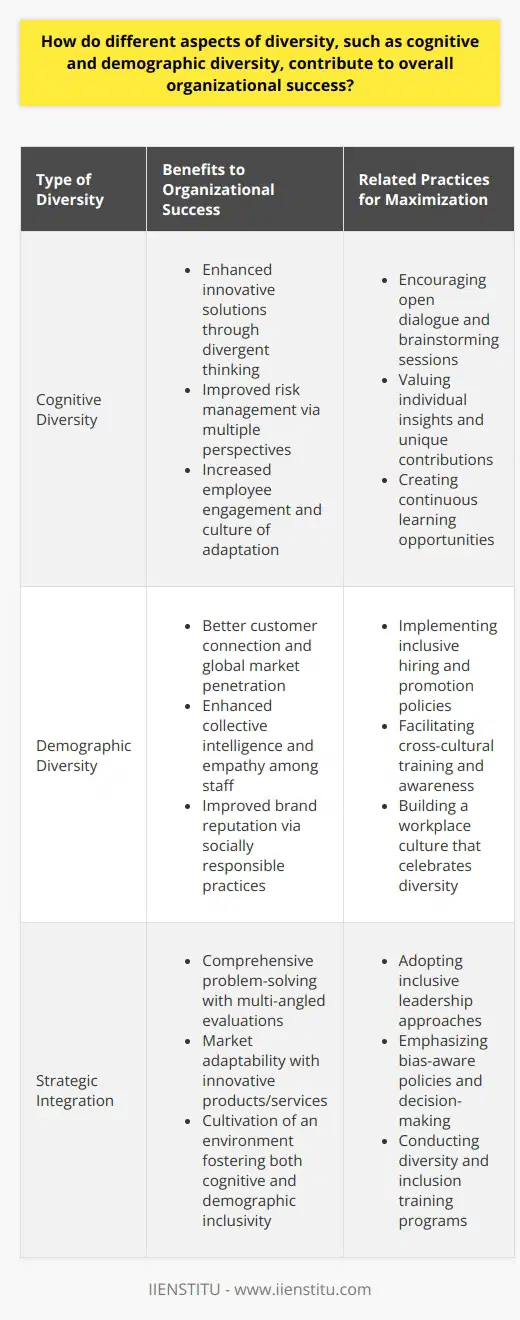
Why is HR diversity important for fostering innovation within an organization?
Significance of HR Diversity for Innovation
Promoting Diversity within HR Structures
A diverse human resource (HR) department plays an integral role in fostering innovation within an organization. HR professionals with varied backgrounds, perspectives, and experiences ensure a broader spectrum of ideas, thus fueling creativity and innovation. By hiring employees from different ethnicities, genders, age groups, and skill sets, organizations can capitalize on the multiplicity of perspectives, inspiring novel ideas and strategies.
Enhancing Creative Problem Solving
The presence of diverse HR teams significantly contributes to an organization's ability to devise innovative solutions to complex challenges. The heterogeneous composition of these teams fosters cognitive diversity, enabling them to contemplate various angles of a problem and generate a wide array of solutions. Consequently, organizations with diverse HR departments can navigate intricate situations with enhanced creative problem-solving capabilities.
Increasing Employee Engagement and Collaboration
An inclusive work environment, characterized by diversity in HR, encourages employee engagement and collaboration. This sense of inclusivity fosters a culture of openness, where employees feel valued and appreciated for their unique contributions. Such an environment facilitates the flow of ideas, dialogue, and constructive criticism, promoting innovative thinking and teamwork among employees.
Attracting and Retaining Top Talent
Innovation within an organization relies heavily on the acquisition and retention of top talent. A diverse HR department serves as a magnet for exceptional individuals, drawn to organizations that champion diversity and inclusivity. Furthermore, the appreciation and recognition of the unique abilities and perspectives of these talented individuals contribute to higher retention rates and job satisfaction, directly impacting the organization's overall capacity for innovation.
Adaptability to Dynamic Business Environments
Finally, HR diversity is crucial for an organization's ability to adapt and thrive in today's rapidly changing business landscape. Organizations with diverse HR departments are better positioned to anticipate and respond to economic, technological, and socio-cultural shifts due to their wide range of experiences and perspectives. This adaptability, in turn, fosters a culture of continuous innovation that allows organizations to remain competitive and relevant in the market.
In conclusion, HR diversity is vital for bolstering innovation within an organization. Through the promotion of diverse HR structures, enhancement of creative problem-solving, fostering of employee engagement and collaboration, attraction and retention of top talent, and adaptability to dynamic business environments, organizations can cultivate a culture of innovation and maintain a competitive edge in their respective industries.

How can HR professionals mitigate unconscious bias in recruitment and promotion processes to encourage diversity?
Addressing Bias in Job Descriptions
To mitigate unconscious bias in recruitment and promotion processes, HR professionals can begin by carefully crafting job descriptions. By using gender-neutral language, specifying diversity and inclusion as company values, and focusing on required skills rather than specific backgrounds or titles, HR professionals can attract a wider pool of diverse candidates.
Bias in Recruitment Advertising
Secondly, HR professionals should review advertising materials and strategies to ensure inclusive language and visuals are used. This includes displaying images representing various races, genders, and abilities, as well as emphasizing the company's interest in diverse candidates. Additionally, direct outreach efforts to underrepresented communities and networks can facilitate increased diversity in the applicant pool.
Standardizing the Interview Process
Next, standardized interview processes can help minimize opportunities for unconscious bias to influence hiring decisions. Activities such as using a structured interview format, asking consistent questions for each candidate, and utilizing diverse interview panels can create a level playing field for candidates and aid in reducing bias in the selection process.
Employing Skill-Based Assessments
Another method for mitigating unconscious bias in recruitment is incorporating skill-based assessments. By focusing on objective measures of an applicant's abilities and aptitude, HR professionals reduce the influence of irrelevant factors like race, gender, and socioeconomic background on the decision-making process.
Data-Driven Decision Making
Additionally, data-driven decision making can play a crucial role in combating unconscious bias. HR professionals can analyze demographic information to track patterns, uncover bias in the hiring process, and implement targeted interventions to address identified issues. Analyzing this data helps HR professionals maintain transparency and make more equitable decisions.
Unconscious Bias Awareness Training
Lastly, conducting unconscious bias awareness training for HR practitioners and managers involved in recruitment and promotion decisions fosters understanding of the many ways unconscious bias can manifest in these processes. By providing practical strategies to minimize these biases, awareness training ensures HR professionals and managers prioritize diversity and make informed, objective decisions concerning recruitment and promotion.
In conclusion, HR professionals can counter unconscious bias through careful crafting of job descriptions, inclusive recruitment advertising, standardized interview processes, skill-based assessments, data-driven decision making, and unconscious bias awareness training. By following these strategies, HR professionals cultivate a more diverse and equitable workforce, fostering a culture of inclusivity within the company.

What role does HR play in cultivating a culture of inclusion and equity to support a diverse workforce?
Role of Human Resources
Human Resources (HR) plays a crucial role in cultivating a culture of inclusion and equity to support a diverse workforce. One of the primary responsibilities of HR is to ensure equal opportunities for all employees, regardless of their background or characteristics. By implementing inclusive hiring practices, HR can ensure that the workforce is reflective of the broader society and comprises individuals with diverse perspectives and skills.
Promoting Inclusive Work Environment
Creating an inclusive work environment involves implementing policies and practices that promote open communication, mutual respect, and understanding among employees. HR can achieve this by providing diversity training and awareness programs for team leaders and employees, ensuring that workplace policies are inclusive and accessible, and addressing any discrimination or harassment issues promptly.
Employee Resource Groups
To further enhance inclusion and equity, HR can encourage the formation of Employee Resource Groups (ERGs). These voluntary groups of employees share common interests, characteristics, or backgrounds and actively work to foster a more inclusive organization. ERGs can serve as valuable resources for HR and management by offering insights, recommendations, and support in advancing diversity and inclusion initiatives.
Performance Management & Career Development
In addition to creating an inclusive work environment, HR must also ensure that performance management and career development practices are equitable, transparent, and free from bias. By regularly reviewing performance evaluations, promotion decisions, and compensation structures, HR can identify potential disparities and address them accordingly. Moreover, providing equal opportunities for professional development, mentorship, and sponsorship can help support the career growth of underrepresented groups.
Measurement & Monitoring
Finally, HR should continuously measure the effectiveness of diversity and inclusion initiatives to gauge their impact on the organization. Regular monitoring and reporting of relevant metrics can help identify areas of success and improvement, enabling HR to refine and adjust strategies as needed. By actively pursuing and evaluating their progress, organizations can ensure the continued growth and success of a diverse and inclusive workforce.
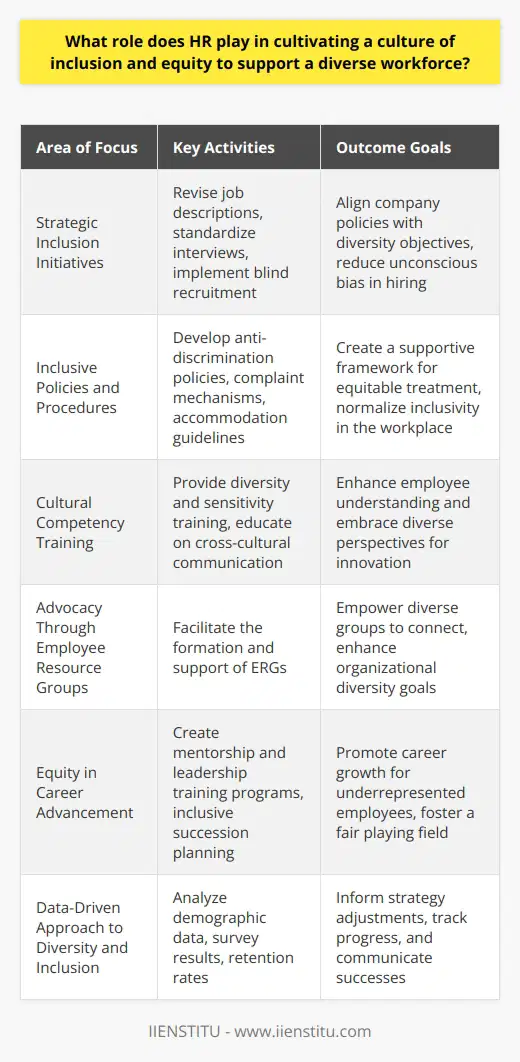
How is HR impacted by diversity in terms of employee engagement and satisfaction?
Impact of Diversity on HR
**Role of HR in Fostering Diversity**
Human Resource (HR) departments play a crucial role in developing diversity policies and fostering a diverse workforce. This involves not just recruiting diverse talent but also promoting an inclusive work environment that encourages employee engagement and satisfaction.
**Diversity and Employee Engagement**
A diverse workforce brings together individuals with different backgrounds, skills, perspectives, and experiences. This diversity can have a significant impact on employee engagement levels. When employees feel their contributions are recognized and appreciated, they are more likely to be committed to their jobs and contribute effectively to organizational goals. HR professionals, therefore, have a responsibility to ensure that all employees can participate fully in the workplace and benefit from different experiences and perspectives.
**Enhancing Satisfaction Through Inclusivity**
Promoting inclusivity in the workplace contributes to increased employee satisfaction. HR departments can help facilitate this by developing comprehensive diversity programs that address various factors, such as recruitment practices, workplace culture, compensation and benefits, and training opportunities. By promoting a culture of inclusivity and celebrating employee differences, HR can help lower the potential for workplace conflict and create a more harmonious work environment.
**Addressing Challenges of Diversity**
Although maintaining a diverse workforce offers numerous benefits, HR professionals must also be prepared to address the challenges that may arise in this context. To reap the benefits of diversity, HR needs to develop mechanisms for managing potential disputes and conflicts among employees. Effective conflict resolution strategies are crucial in maintaining employee satisfaction and fostering an inclusive work environment.
**Conclusion**
In conclusion, the impact of diversity on HR is multifaceted - it influences employee engagement, satisfaction, and even conflict resolution within the workplace. To fully leverage the advantages of diversity, HR professionals must actively nurture an inclusive culture and address any challenges that may arise. This will ultimately lead to a more engaged, satisfied, and diverse workforce, which is vital for organizational success.
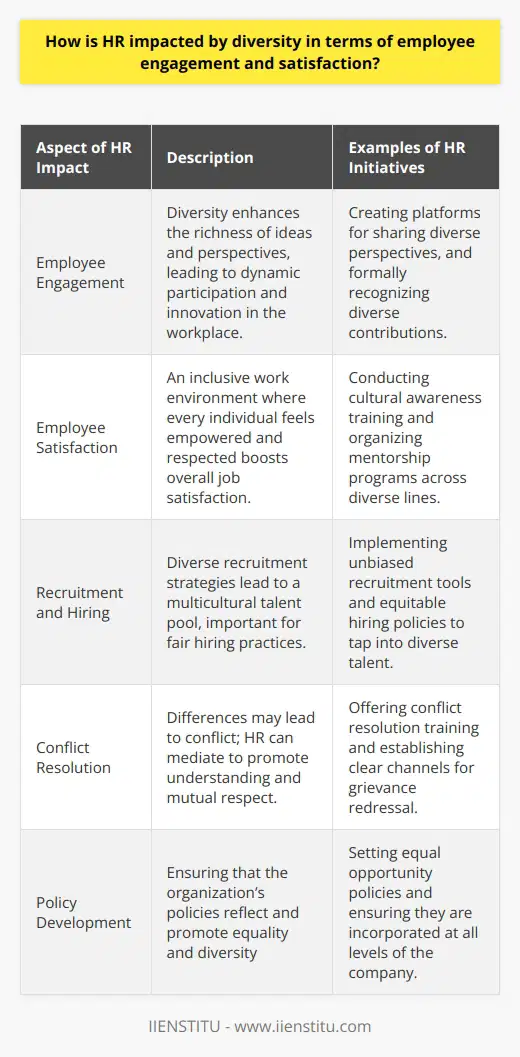
Why is diversity key to success in fostering effective communication and collaboration in the workplace?
Diversity's Impact on Communication
Diversity is a crucial factor in fostering effective communication and collaboration in the workplace. A diverse workforce comprising individuals from different cultural, linguistic, and generational backgrounds enriches the work environment, enhances creativity, and engenders innovation. The presence of diverse perspectives collectively contributes to a better understanding of issues, informed decision-making, and ultimately, organizational success.
Cultural Awareness and Sensitivity
A diverse workplace necessitates cultural awareness and sensitivity, which in turn promotes effective communication. Employees learn to adapt their communication styles and approaches to accommodate the preferences and requirements of their colleagues from different backgrounds. This adaptation encourages clear communication and minimizes misunderstandings, enabling more effective interactions among employees and fostering a positive workplace culture.
Inclusive Language and Communication Tools
Diversity also necessitates the use of inclusive language, ensuring that all employees feel respected and valued. Inclusive language transcends cultural and linguistic barriers, fostering a sense of belonging and inclusiveness in the team. Furthermore, organizations should invest in accessible communication tools and technologies, facilitating the inclusion of employees with diverse abilities, preferences, and requirements. The adoption of inclusive communication tools bolsters productivity and facilitates seamless collaboration among team members.
Promotion of Unique Perspectives
Embracing diversity within the workplace encourages employees to contribute their unique skills and perspectives. The synergetic combination of these distinctive qualities ultimately gives rise to enhanced creativity, innovative problem-solving, and various collaborative approaches. Consequently, the organization benefits at large from unique insights, groundbreaking ideas, and solution-oriented teamwork.
Conflict Resolution and Mediation
A diverse workplace can also lead to interpersonal conflicts stemming from differences in viewpoints, communication styles, and expectations. However, by fostering an environment of open communication and teaching effective conflict resolution strategies, organizations can manage conflicts constructively. Prompt and effective conflict resolution promotes harmony, supports collaboration, and bolsters a positive workplace culture.
In conclusion, embracing diversity in the workplace is pivotal to establishing effective communication and collaboration. Fostering cultural awareness, employing inclusive language, leveraging diverse perspectives, and promoting conflict resolution strategies all contribute towards individual and organizational success. By investing in diversity and inclusion initiatives, organizations can harness the immense potential of diverse teams, propelling innovation, and driving positive outcomes.
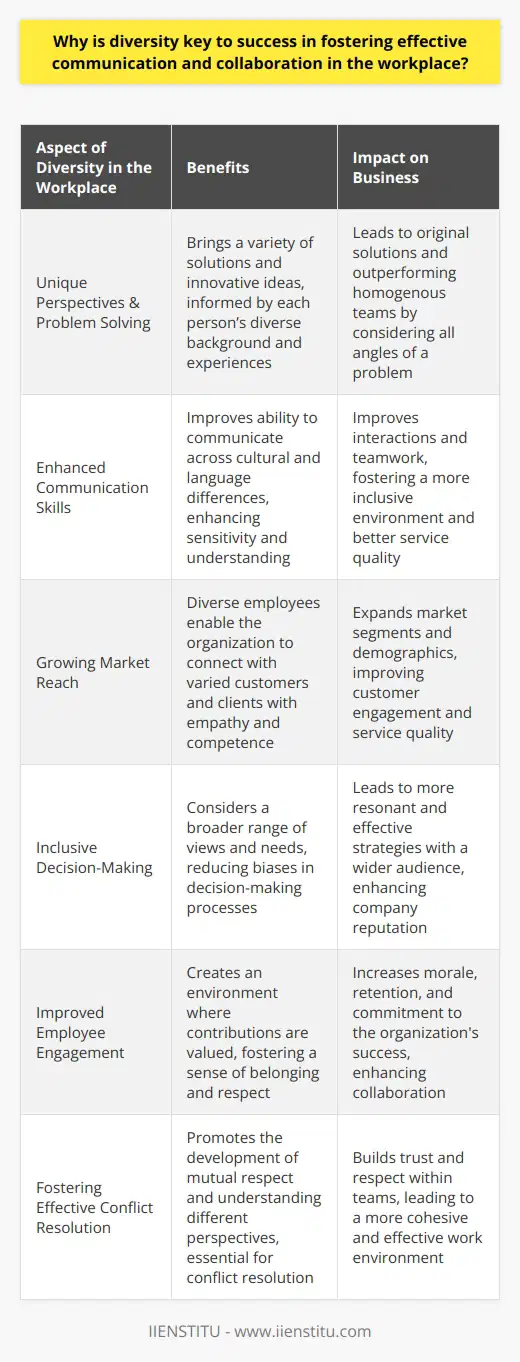
How does diversity strengthen the economy through fostering entrepreneurship and global competitiveness?
Fostering Entrepreneurship
Diversity plays a crucial role in strengthening the economy by fostering entrepreneurship. When individuals from different backgrounds, cultures, and experiences come together, they bring unique perspectives and ideas that can lead to the creation of innovative products and services. These new offerings can help to generate economic growth, as they cater to the needs and preferences of a wider consumer base. Moreover, a diverse workforce allows businesses to better understand and serve their customers, giving them a competitive advantage in the market.
Promoting Global Competitiveness
In today's increasingly globalized world, diversity is essential for countries and businesses to remain competitive. A diverse workforce enables companies to better navigate international markets and adapt to different cultures, ultimately facilitating the growth of trade and investment. This, in turn, can lead to an increase in a country's GDP, as more foreign investors are attracted to the stable and robust business environment that diversity has helped to create. Furthermore, as businesses with diverse workforces are more likely to foster innovation, countries that encourage diversity can also benefit from technological advancements that drive economic growth.
Attracting Talent
Another way in which diversity strengthens the economy is by attracting top talent from around the world. A diverse and inclusive work environment is more likely to appeal to skilled professionals, as they can see that their unique perspectives and experiences will be valued. Businesses that prioritize and promote diversity can become more successful in recruiting and retaining the best and brightest minds, which can lead to increased productivity and financial performance.
Enhancing Creativity and Problem-solving
Diversity is known to be a catalyst for creativity and problem-solving, as it encourages multi-dimensional thinking and exposes individuals to new ideas and approaches. This can be particularly beneficial in the realm of entrepreneurship and innovation, as it allows businesses to identify and exploit opportunities that might otherwise have been overlooked. As diverse teams generate more creative and innovative solutions, they can drive economic growth through the development of new products, services, and strategies.
In conclusion, diversity is not only a matter of equity and inclusiveness but has proven to be an essential factor in fostering entrepreneurship and promoting global competitiveness. By embracing and encouraging diversity within the workforce, businesses, and countries can benefit from increased innovation, heightened creativity, and improved problem-solving abilities that are essential for sustained economic growth.
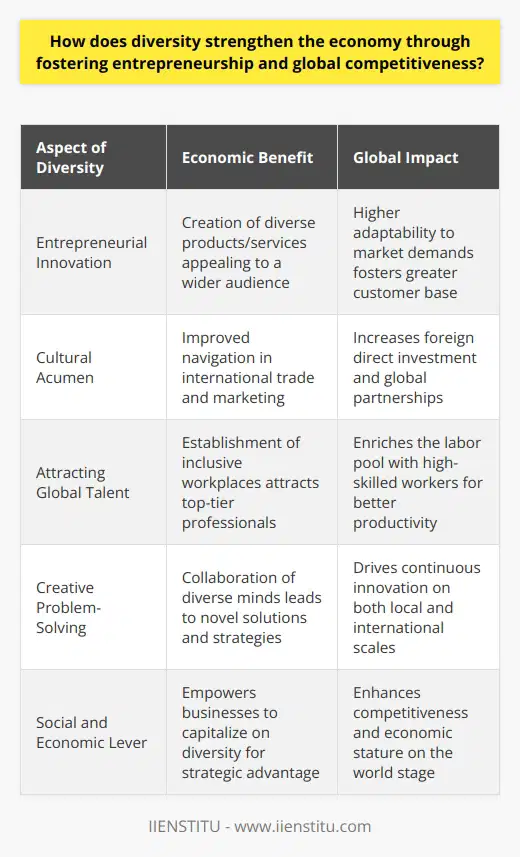
Why is diversity important in today's workforce and how does it contribute to the overall success of an organization?
Diversity's Impact on Organizational Success
In today's increasingly connected and globalized world, diversity plays a significant role in the workforce, contributing to the overall success of an organization in multiple ways. A diverse workforce, consisting of employees with varying backgrounds, perspectives, and experiences, enables organizations to more effectively address the evolving needs of global markets, tap into a wider range of talents and skills, and foster the development of innovative solutions to complex problems.
Enhanced Problem Solving and Decision Making
A key advantage of a diverse workforce is the improvement of problem-solving and decision-making processes. As diverse teams engage in deliberation, members draw upon their distinct experiences and perspectives to offer alternative viewpoints, identify previously overlooked issues, and generate a broader set of potential solutions. This results in more comprehensive and informed decision-making processes, ultimately leading to better outcomes for the organization.
Increased Creativity and Innovation
Another significant benefit of workforce diversity is the promotion of creativity and innovation within the organization. In heterogeneous teams, members with a diverse array of experiences and ideas are more likely to challenge and refine one another's thoughts. This iterative and constructive process sparks the development of novel solutions or products, promoting organizational innovation and, ultimately, improving the competitiveness of the organization in the global marketplace.
Improved Workplace Culture and Employee Satisfaction
Diversity in the workplace also fosters positive workplace culture and increased employee satisfaction. A commitment to diversity by the organization's leadership signifies a recognition of and respect for the unique contributions of each employee, which can improve employee engagement and retention. In addition, diverse environments promote mutual learning among team members, which contributes to enhanced personal and professional growth.
Expanded Access to Global Markets
A diverse workforce enables organizations to better understand and meet the needs of diverse customer segments across multiple markets. By employing individuals with intimate knowledge of unique cultural customs, preferences, and values, organizations can develop strategies for effective marketing and communication. This capability not only expands access to global markets but also improves an organization's reputation as a socially responsible corporate citizen.
In conclusion, cultivating diversity in the workforce provides tangible advantages to organizations, including enhanced problem-solving and decision-making, increased creativity and innovation, improved workplace culture and employee satisfaction, and expanded access to global markets. As the world becomes more interconnected and diverse, promoting diversity within an organization will only become increasingly important for its long-term success.
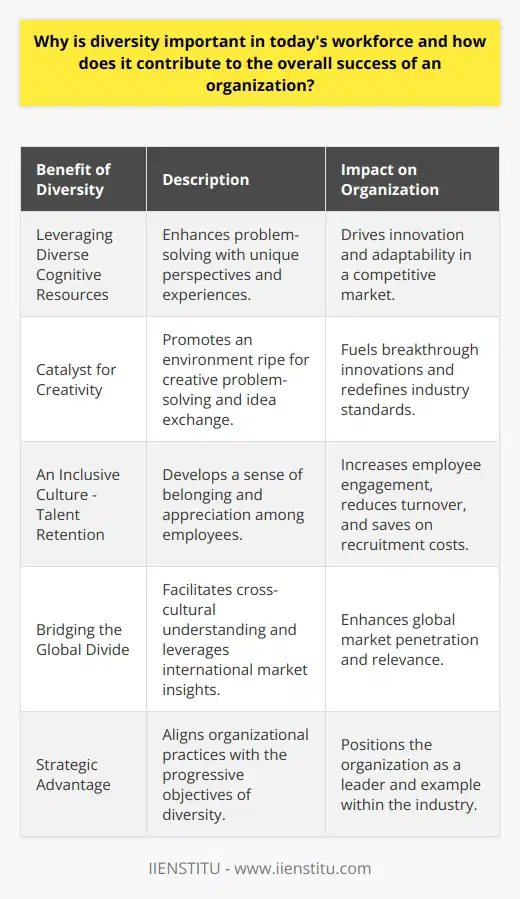
How can HR departments promote diversity and inclusion effectively to ensure it genuinely benefits and improves workplace culture?
Creating Awareness and Fostering Equity
An effective way for HR departments to promote diversity and inclusion can be achieved by addressing the root of the problem - attitude and awareness. By creating awareness about the importance of diversity and inclusion, HR departments can foster a company culture that apprecates different perspectives and values unique experiences. To accomplish this, organizations can provide training programs and workshops that focus on diversity, equality, and the value of inclusive leadership.
Redefining Recruitment Strategies
HR departments can also examine their recruitment processes to ensure diversity and inclusion from the earliest stage of an employee's journey. A re-evaluation of job postings and recruitment tactics can reveal any pitfalls that create barriers to welcoming a diverse range of applicants. Moreover, HR can review their criteria for promotions, career development, and internal mobility to make certain that all employees have equal opportunities for growth.
Building Inclusive Policies and Practices
Another method to improve workplace culture through diversity and inclusion is to introduce inclusive policies and practices, such as flexible working arrangements, parental leave, and reasonable accommodations for employees with disabilities. In addition, HR departments can facilitate open, honest conversations about bias and discrimination by encouraging managers and employees to share their experiences and perspectives. This approach builds understanding, and promotes a more inclusive workplace culture.
Monitoring Progress and Measuring Success
Finally, HR departments must continuously assess the success of their diversity and inclusion initiatives. This requires collecting data on employee demographics, internal promotions, and employee feedback to monitor progress and identify areas needing improvement. By regularly evaluating the success and effectiveness of their initiatives, organizations can make necessary adjustments and actively work towards increasing diversity and inclusion in the workplace.
In conclusion, HR departments play a crucial role in promoting diversity and inclusion within organisations, ensuring that employees feel valued and included. Through comprehensive training, re-evaluation of recruitment strategies, and fostering an inclusive, equitable culture, HR departments can shape a workplace that thrives on diversity and inclusion. Regular progress monitoring is essential for continuous improvement, to make certain that the diversity and inclusion initiatives are genuinely benefitting and improving workplace culture.
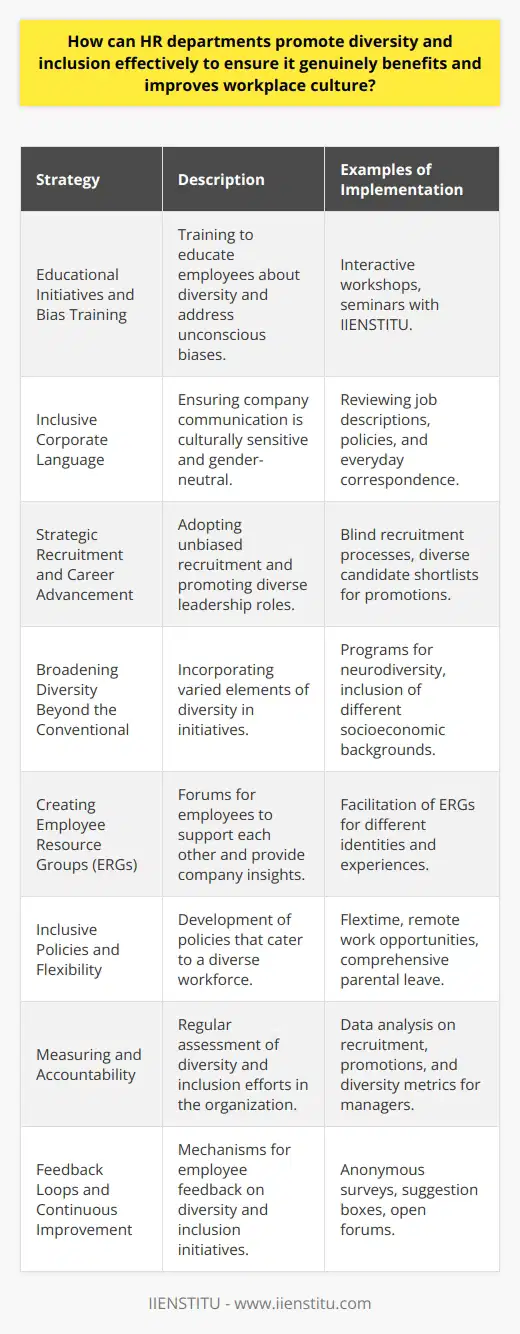
How does diversity influence decision-making and problem-solving abilities in teams, and why is it critical for HR professionals to consider this aspect when structuring groups within the workplace?
Diversity's Impact on Decision-Making and Problem-Solving Abilities
Diversity has a substantial influence on decision-making and problem-solving abilities in teams, by bringing together individuals with unique perspectives, experiences, and ideas. In a diverse team, members can challenge each other's assumptions, engage in more creative discussions, and discover a broader range of potential solutions to problems. This dynamic can lead to better-informed decisions and innovative approaches to challenges.
Importance of Considering Diversity in HR
It is crucial for HR professionals to factor in diversity when structuring groups within the workplace, as diverse teams can contribute to a more effective and productive business environment. Facilitating diversity in the workplace can foster a more inclusive culture, where employees feel valued and engaged, ultimately leading to lower turnover rates and improved employee satisfaction.
Benefits of Diverse Teams
There are several benefits of diverse teams that translate to improved decision-making and problem-solving abilities. Diverse teams can achieve greater creativity and innovation by pooling together the collective knowledge and expertise of members with different backgrounds. These teams are also more adept at identifying and mitigating potential biases in their decision-making process, enhancing the overall quality of their choices.
Addressing Challenges Posed by Diversity
While diverse teams can offer numerous advantages, they can also face unique challenges. Conflicts and misunderstandings can arise due to differing communication styles and cultural norms. It is essential for HR professionals to provide appropriate training and tools to foster a cooperative environment, enhancing collaboration and communication.
Incorporating Diversity Management Strategies
To effectively structure diverse teams in the workplace, HR professionals must develop and implement diversity management strategies. These strategies may include promoting and reinforcing a company's commitment to diversity, providing targeted recruitment and retention initiatives, and offering diversity training programs. By adopting such strategies, organizations can optimize the composition of their teams and maximize the benefits of diversity in decision-making and problem-solving.
In conclusion, fostering diversity in teams can significantly enhance their decision-making and problem-solving abilities, leading to more effective and innovative outcomes. It is the responsibility of HR professionals to consider and emphasize the importance of diversity when structuring groups within the workplace, ensuring a competitive edge for their organization in an increasingly globalized business environment.
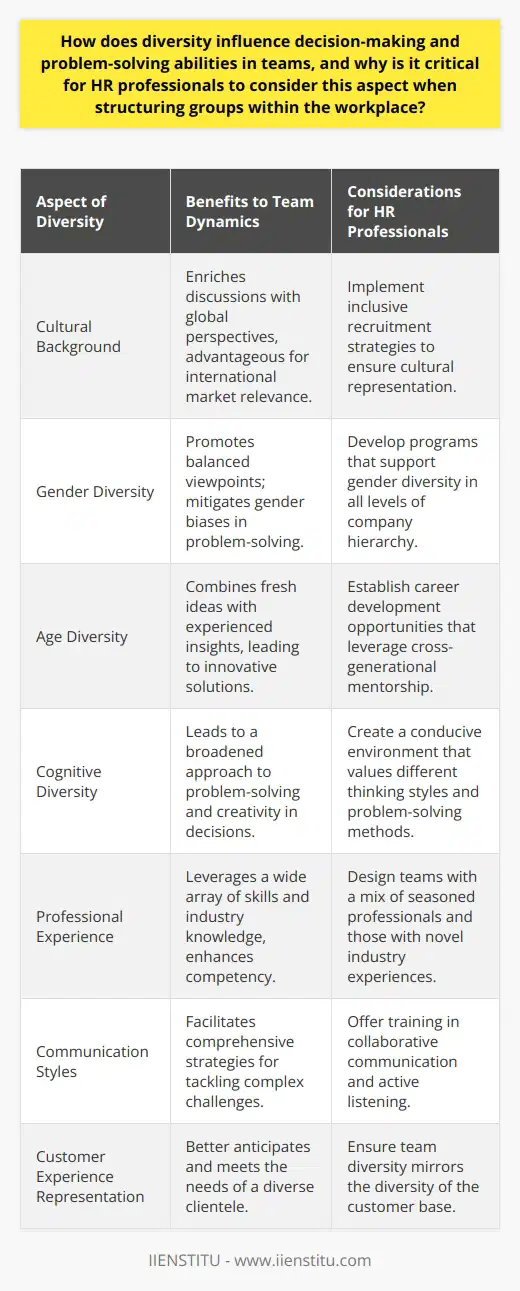
Why is diversity important in human resource management for cultivating a positive employer brand and attracting top talent?
Importance of Diversity in HRM
Fostering an inclusive environment is crucial for human resource management (HRM) to effectively maintain a positive employer brand and attract top talent. Embracing diversity ensures organizations cater to the needs of a wide range of employees, encouraging creativity, and innovation within the workforce. By developing inclusive HRM strategies, companies can attract a diverse talent pool, resulting in higher levels of employee satisfaction, engagement, and ultimately, organizational success.
Enhanced Creativity and Innovation
Workplace diversity fosters an atmosphere of creativity and innovation. With employees from various backgrounds, cultures, and perspectives, a company has access to an assortment of ideas and viewpoints. This diversity enables better problem-solving, decision-making, and enhanced product or service development, ultimately leading to a more competitive business in the global market.
Increased Employee Engagement
A diverse workforce strengthens employee engagement, as it often reflects a company culture where employees feel valued and respected. When employees see that their organization values diversity and actively cultivates an inclusive environment, they are more likely to feel a sense of belonging within the company. This sense of belonging boosts their motivation, productivity, and loyalty, further contributing to a positive employer brand.
Attracting Top Talent from Diverse Backgrounds
A strong commitment to diversity and inclusion serves as a crucial factor in attracting top talent from various backgrounds. A diverse and inclusive employer brand sends a message to potential employees that the company is open to new perspectives, ideas, and innovation. By promoting diversity in the workplace, HRM can ensure that the organization becomes a desired employer for talent from all walks of life, ultimately leading to better recruitment and retention rates.
Broadened Market Insights and Improved Customer Service
Diversity within a workforce can also contribute to an organization's understanding of their diverse customer base, providing valuable insights into different markets. Companies that place importance on diversity can cater to a broader range of customers and anticipate the nuances in their preferences, directly improving their customer service and overall satisfaction.
Conclusion
In conclusion, diversity is essential in HRM, as it strengthens a company's employer brand and helps in attracting top talent. Fostering a diverse and inclusive environment not only aids creativity and innovation but also enhances employee engagement and customer service. By prioritizing diversity in HRM strategies, organizations can secure a competitive advantage within the rapidly changing global market.
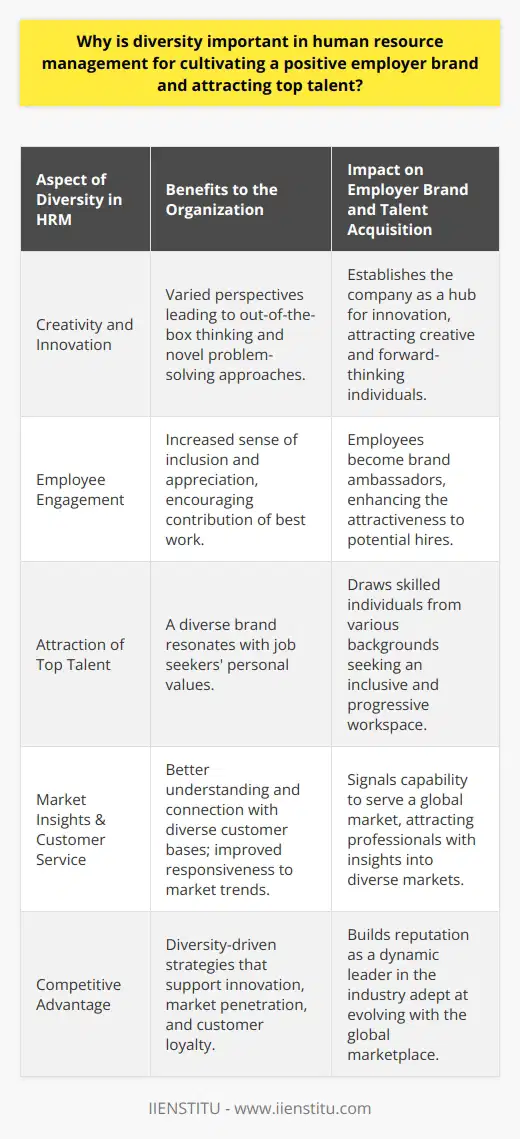
How does diversity contribute to the economy by driving innovation and creativity within an organization?
**Diversity as a Catalyst for Creativity and Innovation**
Diversity contributes significantly to a company's economy by driving innovation and creativity within an organization. The presence of diverse employees facilitates the exchange of unique perspectives, experiences, and ideas, leading to better problem-solving and decision-making processes. These processes are essential for an organization in the development of innovative products and services and help to create a competitive advantage.
**The Role of Cultural Diversity in Facilitating Creativity**
Cultural diversity is a key element in fostering creativity within an organization. Employees from different cultural backgrounds bring a range of viewpoints, skills, and approaches to their work, which helps companies in overcoming existing cognitive biases. Moreover, culturally diverse teams can more effectively navigate potential market opportunities and introduce new solutions to customers from various backgrounds.
**Benefits of Gender and Age Diversity in Generating Innovation**
In addition to cultural diversity, gender and age diversity also play a crucial role in promoting creativity and innovation within an organization. Gender diversity ensures that both male and female perspectives are considered in problem-solving and product development, leading to balanced and well-rounded outcomes. Furthermore, age diversity enables organizations to draw on a wide array of experiences and insights, allowing for the combination of traditional approaches with modern methods.
**Leveraging Diverse Skillsets for Effective Collaboration**
Establishing teams with complementary skills and backgrounds encourages better communication, collaboration, and resourcefulness within a company. These qualities result in the exploration of multiple angles in problem-solving and can lead to the development of breakthrough solutions. In this way, organizations that embrace and utilize diversity are more likely to successfully adapt to changing market demands and remain competitive in the global economy.
In conclusion, diversity plays a pivotal role in promoting innovation and creativity within an organization, leading to valuable economic growth. By incorporating diverse cultural, gender, and age perspectives, organizations can improve their decision-making processes and enhance their ability to adapt to change. By fostering an inclusive and collaborative environment, businesses can thrive and offer truly innovative solutions to their customers.

Why is diversity important in today's workforce for enhancing problem-solving capacities and promoting a collaborative work environment?
Significance of Diversity in Problem Solving
Diversity plays a crucial role in today's workforce by enhancing problem-solving capabilities among employees. A diverse workforce is composed of individuals with varying backgrounds, experiences, and perspectives. This assortment encourages employees to approach problems from multiple angles, stimulating novel solutions that could otherwise be overlooked. Moreover, a wide range of ideas leads to improved critical thinking and better decision-making, as employees engage in constructive debates and refine their understanding of complex issues.
Collaborative Work Environment
Promoting a collaborative work environment is another benefit that arises from fostering diversity in the workplace. Given the different cultural, social, and educational backgrounds of employees, they bring unique skills and strengths to the table. By leveraging these distinct abilities, companies can create well-rounded teams that are more effective at addressing multifaceted challenges. Furthermore, an inclusive atmosphere encourages employees to openly share their ideas and opinions, resulting in a cooperative work environment where individuals feel valued and empowered to contribute.
Mitigation of Cognitive Bias
One crucial aspect of effective problem solving involves mitigating cognitive biases that can hinder the decision-making process. A diverse workforce helps to reduce the impact of such biases by ensuring that a wide array of perspectives is considered during discussions and deliberations. When employees with different backgrounds collaborate, they challenge each other's assumptions and preconceived notions. This process facilitates greater objectivity and a more balanced approach to problem solving, which ultimately results in better outcomes for the organization.
Enhanced Company Reputation
Embracing diversity in the workplace can also enhance a company's reputation by showcasing its commitment to respecting and valuing the individual strengths of its employees. In today's competitive business landscape, organizations that promote diversity and inclusivity are more likely to attract top talent, as job seekers increasingly place importance on finding work environments where they feel included and appreciated. By maintaining a diverse workforce, companies can signal their dedication to fostering a supportive and collaborative environment, making them more attractive to potential employees.
In conclusion, supporting diversity in the workforce greatly contributes to enhancing problem-solving capacities and promoting a collaborative work environment. Diverse teams are better equipped to devise creative solutions, mitigate cognitive biases, and foster better decision-making. Moreover, companies that value inclusivity are more likely to have a positive reputation and attract top talent, further bolstering their long-term success.
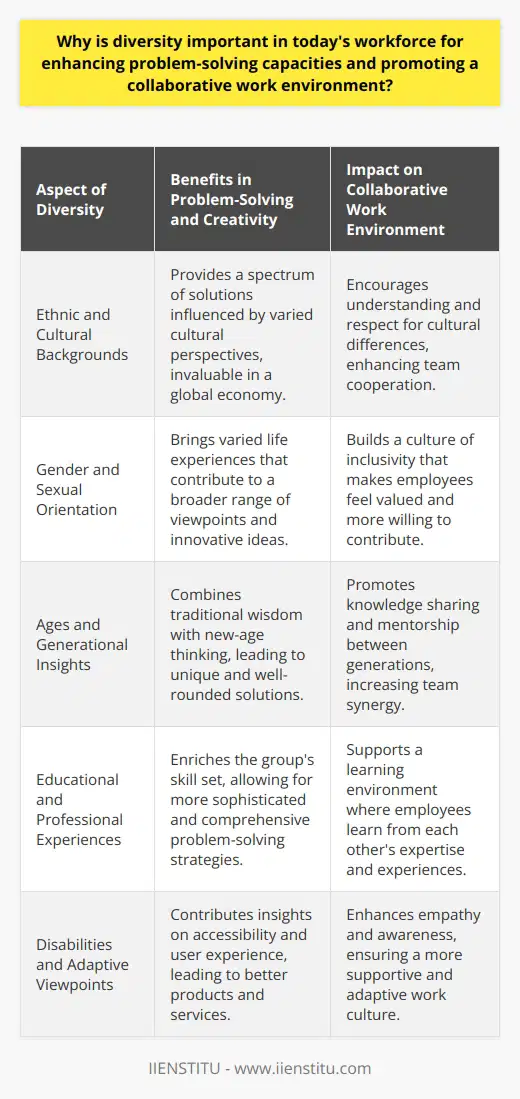
How is HR impacted by diversity in terms of fostering a supportive and inclusive work environment for employees with diverse backgrounds and needs?
Impact on HR Policies and Practices
The impact of diversity on Human Resources (HR) is multifaceted and complex, as HR professionals are responsible for managing and supporting an increasingly diverse workforce. Fostering a supportive and inclusive work environment for employees with diverse backgrounds and needs is paramount as it directly affects employee morale, engagement, retention, and productivity.
Role of HR in Promoting Inclusivity
To achieve this, HR must develop policies and practices that promote and encourage inclusivity. This entails creating a comprehensive diversity and inclusion strategy that encompasses the recruitment and selection process, engaging in bias-free decision-making, and offering training and development programs targeting cultural competency, awareness, and sensitivity.
Employee Engagement and Support Systems
Moreover, HR should focus on employee engagement and establish support systems for employees with diverse backgrounds and needs. Implementing employee resource groups (ERGs) and mentorship programs can offer valuable networking opportunities, career guidance, and peer support from individuals who share similar experiences or aspirations. ERGs can also help identify and address common challenges faced by diverse employees, contributing to their overall satisfaction and professional growth within the organization.
Inclusive Leadership
Another key aspect is promoting inclusive leadership. HR should work with management to develop leaders who are skilled in managing diversity and fostering a supportive, inclusive environment. By offering training in inclusive leadership, organizational leaders can better understand the impact of their decisions on employees with diverse backgrounds and needs.
Workplace Accommodations
Additionally, HR must ensure that employees with diverse needs are provided with appropriate workplace accommodations to achieve their full potential. These accommodations may include flexible work arrangements, assistive technologies, or specific facility modifications, depending on the employee’s individual needs. HR must work closely with employees and their managers to determine the most effective accommodation options.
Continuous Evaluation and Improvement
Finally, in order to assess the effectiveness of their efforts, HR must consistently measure the success of their diversity and inclusion initiatives. This can involve collecting relevant diversity metrics, conducting periodic employee surveys, and implementing a continuous improvement process to analyze the data and identify areas for growth and improvement.
In conclusion, fostering a supportive and inclusive work environment is crucial for organizations and their HR departments in order to maximize the potential of employees with diverse backgrounds and needs. By focusing on inclusive practices, employee engagement, leadership development, workplace accommodations, and continuous evaluation, HR professionals can create a work environment that promotes diversity and supports the success of all employees.
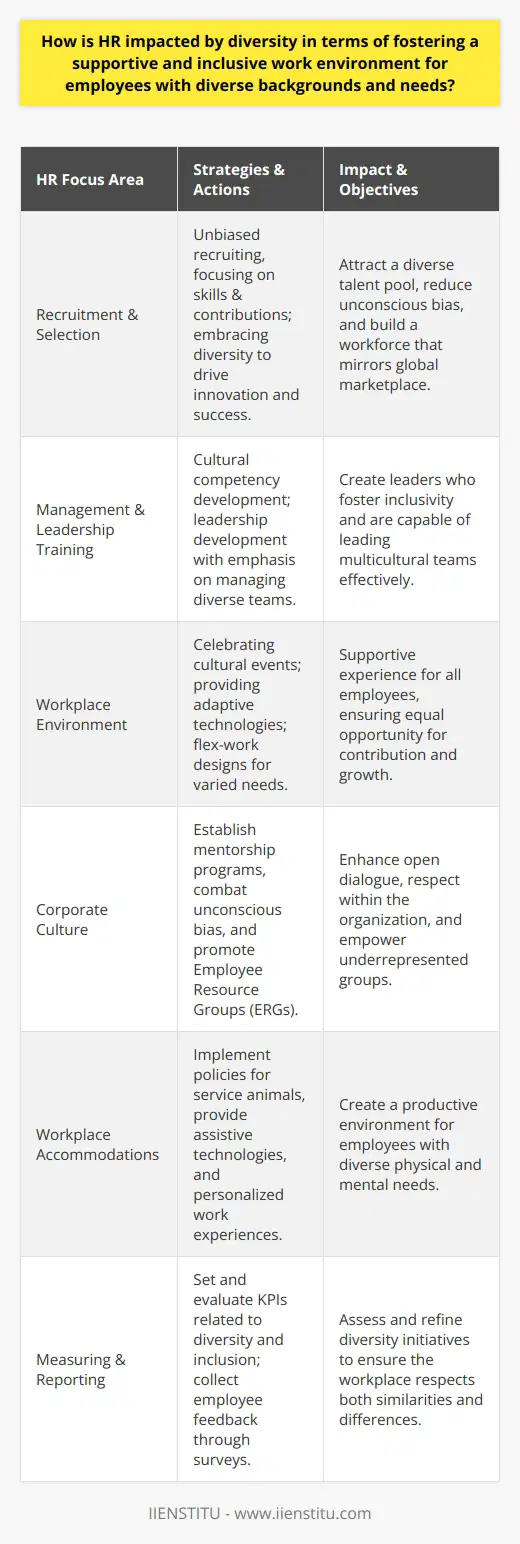
Why is diversity important in human resources for addressing and mitigating the potential risks and negative impacts of unconscious bias and discrimination within the workplace?
Diversity's Role in Tackling Unconscious Bias
Diversity is vital in human resources to address and mitigate potential risks and negative impacts posed by unconscious bias and discrimination within the workplace. A diverse workforce encompasses various backgrounds, ethnicities, and experiences, promoting different perspectives that stimulate creativity and innovation. By fostering a diverse environment, companies can effectively harness the talents of their workforce while ensuring fairness and inclusivity for all employees.
Benefits of a Diverse Workplace
A diverse workforce helps to reduce the likelihood of unconscious bias affecting decision-making. It fosters an atmosphere of understanding and collaboration, encouraging employees to challenge their assumptions and appreciate different perspectives. In turn, this leads to a more inclusive workplace culture where all employees feel valued and respected.
Additionally, diverse teams tend to make better decisions due to varied viewpoints, expertise, and experiences. Experts assert that diverse teams often approach challenges from multiple angles, encouraging innovative problem-solving and increasing the likelihood of accurate decision-making.
Empowering HR's Role in Promoting Diversity
The human resources department plays a significant role in promoting and maintaining diversity within an organization. To cultivate a diverse work environment, HR professionals must implement practices and policies that encourage inclusivity and challenge assumptions. This involves developing recruitment and selection strategies that attract a diverse range of applicants while minimizing opportunities for bias to infiltrate decision-making.
Furthermore, HR professionals need to adopt ongoing training and development programs that address unconscious bias and discrimination. These programs help employees recognize and tackle their own biases, equipping them with the skills required to foster a more inclusive workplace culture.
Effective Monitoring and Evaluation
To mitigate the risks and negative impacts of unconscious bias and discrimination, robust monitoring and evaluation processes must be in place. By continuously reviewing and updating policies, practices, and initiatives, companies can ensure that they are responsive to changing needs and committed to maintaining a diverse and inclusive work environment.
In conclusion, fostering diversity in the workplace helps address and mitigate the harmful consequences of unconscious bias and discrimination. A concerted effort from human resources professionals, encompassing policy implementation, training, and evaluation, is vital for creating a workplace that values and benefits from the talents and perspectives of all employees.
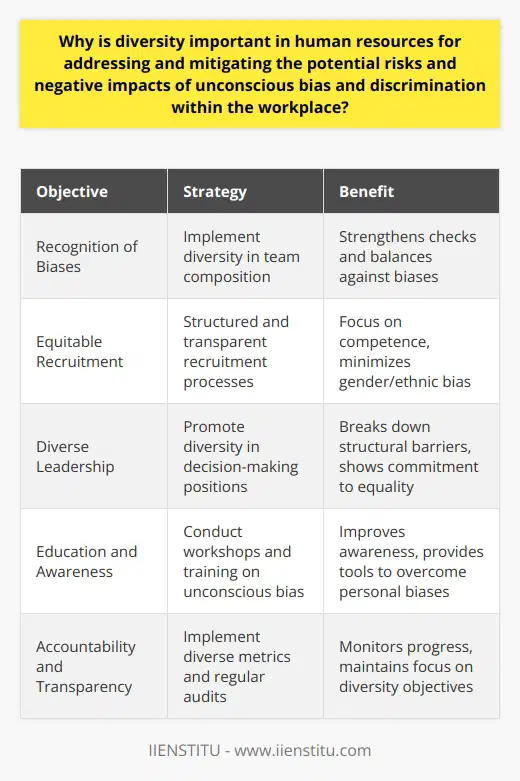
How does diversity help the economy by promoting inclusive growth, social cohesion, and sustainable development?
Inclusive Growth through Diversity
Diversity plays a crucial role in fostering inclusive growth by providing equal opportunities to all members of the society. A diverse workforce, comprising individuals from different backgrounds, brings unique perspectives and capabilities to the table. These varied viewpoints enable businesses to cater to a wider range of customers and address the needs of diverse populations accurately. As a result, companies benefit from increased innovation, improved decision-making processes, and enhanced problem-solving abilities, ultimately leading to better overall performance.
Promoting Social Cohesion
Moreover, diversity strengthens social cohesion by fostering understanding and empathy among people from different backgrounds. As individuals work together in diverse teams, they develop an appreciation for the unique experiences and perspectives that their peers bring to the table. This mutual respect and collaboration break down barriers, facilitate open communication, and promote harmony within society. Consequently, a thriving and inclusive community supports economic growth by creating a stable environment in which businesses can flourish.
Sustainable Development through Diversity
Finally, diversity contributes to sustainable development by supporting the achievement of the United Nations Sustainable Development Goals (SDGs). By promoting equal access to resources and opportunities, diversity enables individuals from all backgrounds to take part in the decision-making process, voice their concerns, and contribute to shaping the course of action towards a sustainable future. Additionally, a diverse workforce is essential to driving sustainable innovation, as it encourages out-of-the-box thinking and collaborative problem-solving to address the complex challenges of climate change, resource scarcity, and socioeconomic inequalities.
In conclusion, diversity benefits the economy by improving inclusivity, fostering social cohesion, and promoting sustainable development. Implementing policies that promote equality and inclusivity will not only empower individuals and strengthen the community but also drive economic growth and sustainable development in the long run.
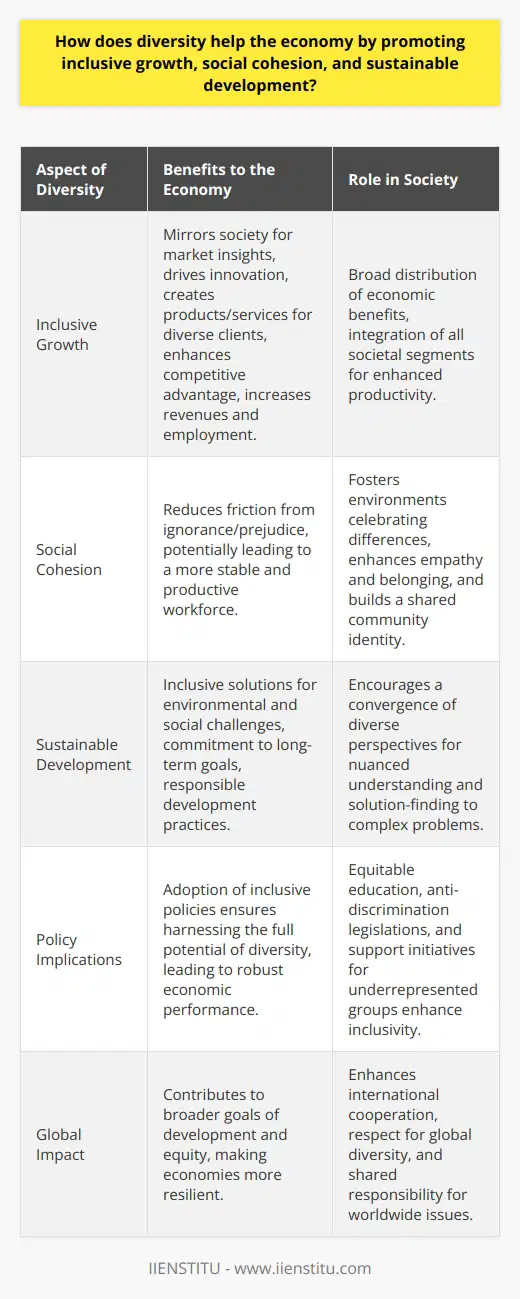
How is HR impacted by diversity in terms of creating equitable opportunities for professional development and career advancement?
Diversity Implications on Human Resources
The impact of diversity on Human Resources (HR) is profound, playing a significant role in shaping equitable opportunities for professional development and career advancement. This perspective encompasses race, gender, age, religious beliefs, sexual orientation, physical ability, and even personality traits.
Effects on Professional development
Diversity fosters limitless potential for professional development. It prompts diversity of thought, stimulating innovation and creativity, and propelling dynamic problem-solving techniques. Consequently, HR needs to promote skill enhancement programs that are inclusive, thereby fostering a diverse but united workforce.
Impact on Career Advancement
In terms of career advancement, diversity influences HR practices regarding promotions, succession planning, and leadership development. A diverse workforce demands fair representation at all levels of an organization. Hence, HR must ensure diversity-friendly policies to maintain an unbiased environment, facilitating equitable career advancement for all.
Challenges for HR
However, HR faces certain challenges in realizing such diversity-led objectives. Stereotypes, biases, and discriminatory practices often hinder organizational efforts to promote diversity. Overcoming these requires effective HR strategies that prioritize inclusivity, ensuring opportunities for all.
Indispensability of HR
The role of HR in fostering diversity and equity has become indispensable in the modern world. A diverse workforce established by HR creates a broader range of solutions to business problems. But more importantly, it hones a more tolerant, accepting, and respectful organizational culture.
Conclusion
In essence, diversity significantly impacts HR in terms of creating equitable opportunities for professional development and career advancement. It is thus integral for HR to navigate past the barriers and harness the potential of diversity for better organizational growth and prosperity.
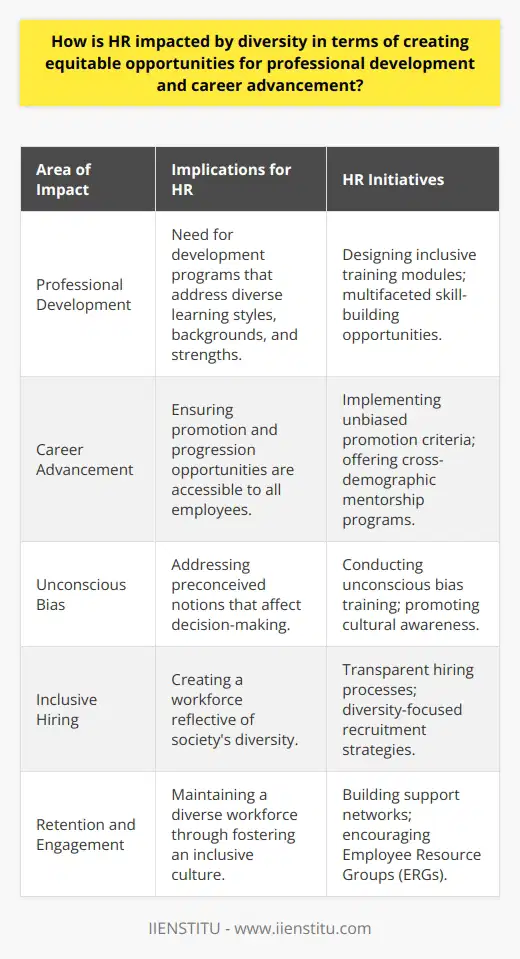
Why is diversity key to success when considering employee well-being and work-life balance in the HR domain?
Diversity's Importance
Diversity plays an integral role in maintaining work-life balance, consequently promoting employee well-being in Human Resource (HR) management. Diverse employees bring distinctive perspectives, skills, and experiences to the workforce that can facilitate innovative ideas and solutions.
Novel Solutions and Insights
These unique insights often result in novel solutions which considerably enhance the company's adaptability. Diversity compels team members to collaboratively unravel complex issues, thus, fostering an environment of learning and growth. Diverse organizations often outpace their counterparts due to increased problem-solving capabilities and creativity.
Enhancing Employee Satisfaction
In terms of employee well-being, companies with diverse workforces typically have better employee satisfaction rates. Diverse workplaces are more inclusive, increasing feelings of belonging and lowering workplace stress, leading to improved physical and mental health among employees.
Access to Larger Talent Pool
Diversity also allows businesses to gain access to a larger talent pool, which increases competitiveness. A diverse workforce attracts a wide array of potentials, aiding in the recruitment of top-performing employees.
Promoting Equitable Opportunities
Diverse workplaces find success in promoting fairness and equal opportunities amongst employees. This ensures reducing discrimination and encouraging respect among employees, making them feel valued and appreciated.
Inclusive Decision-Making Process
Diversity enables an inclusive decision-making process. Different perspectives from diverse backgrounds create comprehensive decision-making processes, ensuring better results. These decisions can thus relate better with the end consumers who themselves come from diverse backgrounds.
Reducing Employee Turnover
Retention rates can be greatly improved with diversity, reducing employee turnover. Employees in a supportive, inclusive work environment are less likely to seek other employment, which saves significant costs on recruitment and training.
In conclusion, diversity increases success in HR by promoting work-life balance, enhancing employee satisfaction, attracting top talent, promoting fair opportunities, enabling inclusive decisions, and reducing turnover. Therefore, fostering diversity should be a deliberate, comprehensive, and ongoing effort for businesses.
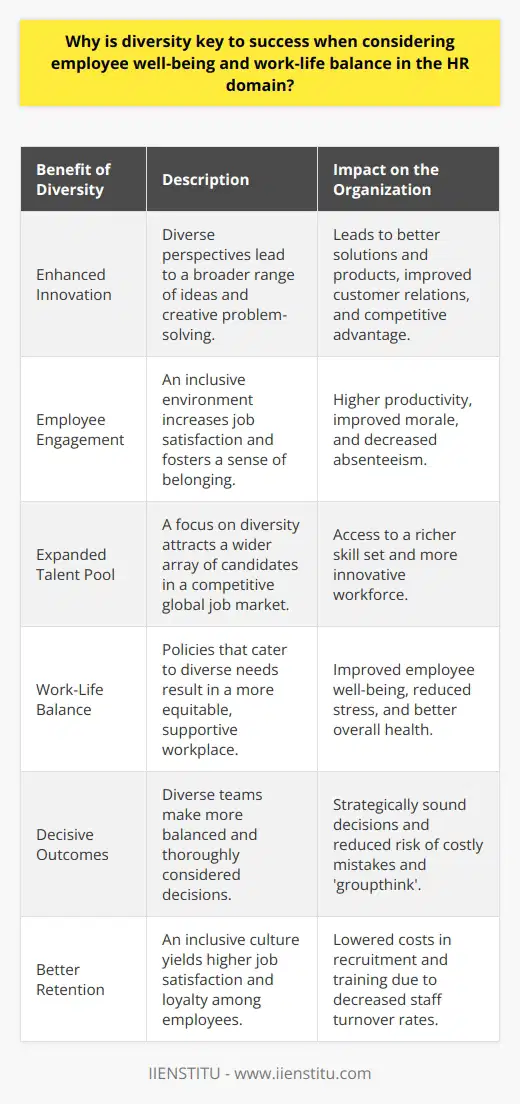
What value does diversity bring to businesses and the economy in terms of promoting cross-cultural understanding and global collaboration?
Promoting Cross-Cultural Understanding
Diversity in businesses adds significant value as it boosts cross-cultural understanding. Employing a diverse workforce fosters the respect and acceptance for varied cultures and backgrounds. It catalyzes an environment where people can openly share insights and perspectives. When employees understand and respect different cultures, they work more efficiently, promoting a positive work environment.
Facilitating Global Collaboration
Moreover, diversity aids in global collaboration. A business with a diverse team is more likely to understand the customs and behaviors of different market segments. This understanding extends beyond the business itself, contributing to an informed, global dialogue. Collaborating with foreign partners or clientele becomes easier and more effective with a diverse team.
Economic Benefits of Diversity
Economic benefits are another value that diversity brings. Businesses with diverse employees are more likely to generate innovative ideas, leading to product or service diversity. This variety attracts a broader customer base which boosts sales, revenue, and ultimately, economic growth. In essence, diversity is a conduit for economic prosperity.
Diversity and Innovation
Lastly, diversity sparks innovation by bringing together a myriad of ideas and perspectives. Diverse perspectives contribute to a richer mix of ideas, fostering inventive problem-solving. Through harnessing this diversity-produced innovation, businesses can drive growth and succeed in competitive markets.
In conclusion, diversity in businesses holds significant value by fostering cross-cultural understanding, facilitating global collaboration, stimulating economic growth, and igniting innovation. As a result, diversity is not just a moral imperative but also a key driver for business growth and economic prosperity.

